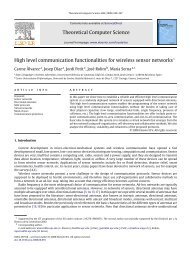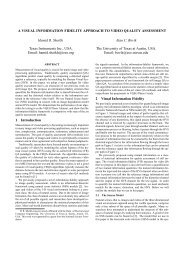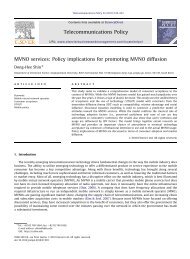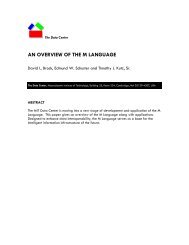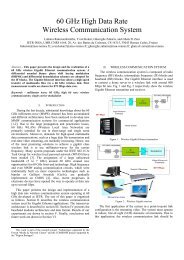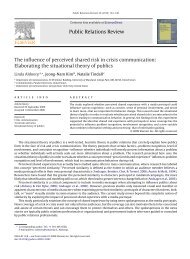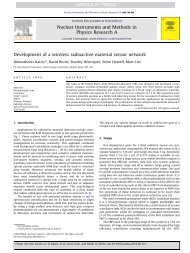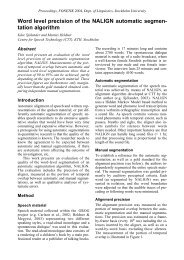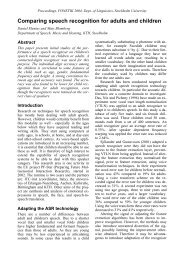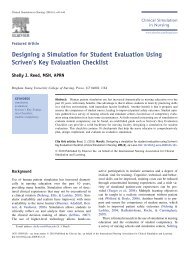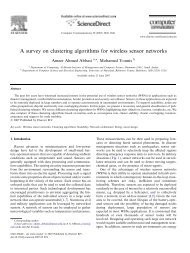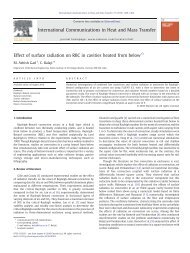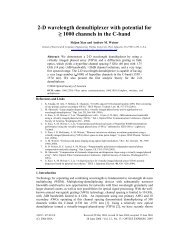BLR: beacon-less routing algorithm for mobile ad hoc networks
BLR: beacon-less routing algorithm for mobile ad hoc networks
BLR: beacon-less routing algorithm for mobile ad hoc networks
Create successful ePaper yourself
Turn your PDF publications into a flip-book with our unique Google optimized e-Paper software.
1084<br />
at 180 s, after the network has reached a stable average<br />
mobility, and ends at 880 s such that all emitted packets<br />
arrive at the destination. On the MAC-layer, standard<br />
802.11 DCF is applied with a nominal bit rate of 2 Mbps <strong>for</strong><br />
bro<strong>ad</strong>cast and as well <strong>for</strong> unicast packets. The low traffic<br />
scenario was chosen in order to prevent congestion and<br />
reduce probability of packet collision to isolate the effects of<br />
mobility and per<strong>for</strong>mance of <strong>routing</strong>. The physical parameters<br />
of the antenna such as transmission power, antenna<br />
gain, and receiver sensitivity are set to obtain a nominal<br />
transmission range of 450 m:<br />
The implementation of GPSR follows closely the<br />
specification as given in Ref. [12] such as support <strong>for</strong><br />
MAC-layer failure feedback, interface queue traversal, and<br />
promiscuous use of the network interface. The <strong>beacon</strong><br />
interval is set to 1:5 s and accordingly the time-out interval<br />
to 4:5 £ 1:5 s ¼ 6:75 s after which a node is deleted from the<br />
neighborhood table if no <strong>beacon</strong> is received.<br />
The implementation of the <strong>BLR</strong> is limited currently to<br />
the basic greedy mode, i.e. all the packets are bro<strong>ad</strong>casted<br />
and there is no recovery strategy in case no node is<br />
located in the <strong>for</strong>warding area, and packets are simply<br />
dropped. In order to obtain neverthe<strong>less</strong> comparable<br />
results, we use a rather high node density (111 nodes<br />
per square kilometer.) such that <strong>BLR</strong> is able to operate<br />
(almost) only in greedy mode. The Max_Delay is set to<br />
40 ms: Furthermore, the circle with r<strong>ad</strong>ius r is applied as<br />
<strong>for</strong>warding area and the <strong>ad</strong>ditional delay at each node is<br />
determined through Eq. (1). In Fig. 9, the packet delivery<br />
ratio is shown <strong>for</strong> the three different protocols. The values<br />
<strong>for</strong> GPSR and LAR1 increase <strong>for</strong> lower mobility, but<br />
remain in general much lower than <strong>for</strong> <strong>BLR</strong>. <strong>BLR</strong> is able<br />
to deliver more than 99% of the packets independent of<br />
the mobility, since it does neither have to discover and<br />
maintain routes nor to maintain a neighbor table that may<br />
be outdated and inconsistent.<br />
The results in Fig. 10 show the average end-to-end delay.<br />
Especially <strong>for</strong> high mobility scenarios, GPSR and LAR1 fail<br />
to delivery packets within reasonable time. For LAR1 this is<br />
Fig. 9. Packet delivery ratio vs. pause time.<br />
M. Heissenbüttel et al. / Computer Communications 27 (2004) 1076–1086<br />
Fig. 10. End-to-end delay vs. pause time.<br />
caused by very frequent route breaks. A node along the path<br />
returns a route error message if the next hop on the route is<br />
broken, which causes the source to reinitiate route discovery<br />
<strong>for</strong> the destination and consequently delays the delivery of<br />
the data packets further. In Fig. 11, the number of generated<br />
route error messages is shown with more than 100 route<br />
discoveries <strong>for</strong> high mobility scenarios.<br />
The delay of GPSR is mainly due to the outdated<br />
neighbor tables. The <strong>routing</strong> protocol selects a next hop in<br />
its neighbor table and the MAC-layer tries to deliver the<br />
packet to this node. However, if this node is not reachable<br />
anymore, the MAC-layer sends a failure notification back to<br />
the network layer and the <strong>routing</strong> protocol selects another<br />
next hop. However, since GPSR selects nodes that are very<br />
distant, these nodes likely have left the transmission area. In<br />
our simulations, GPSR h<strong>ad</strong> to select several times a next hop<br />
until finally the MAC-layer was able to deliver the packets.<br />
In Fig. 11, the numbers of RTS retransmissions due to CTS<br />
time-out are depicted. The curve is similar to the curve of<br />
the route error messages in LAR1 and both are approximately<br />
proportional to the end-to-end delay of the<br />
corresponding <strong>routing</strong> protocol.<br />
These drawbacks vanish as nodes get <strong>less</strong> <strong>mobile</strong> and<br />
GPSR and as well LAR1 even per<strong>for</strong>m slightly better than<br />
Fig. 11. Route error messages and RTS retransmissions.


